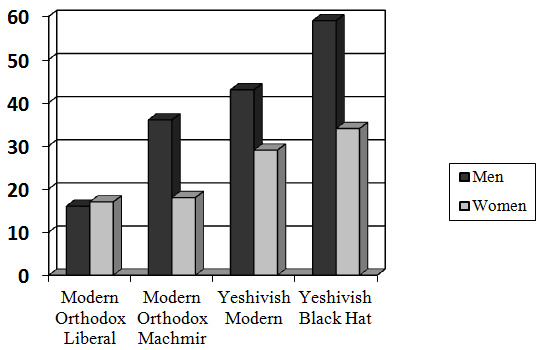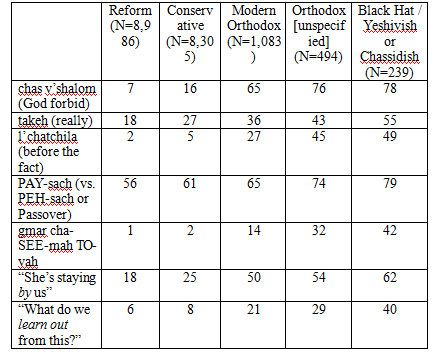by Sarah Bunin Benor
The UJA-Federation recently released the 2011 New York Jewish Population Study, conducted by Steven M. Cohen, Jack Ukeles, and Ron Miller. In this blog post, I highlight some of the study’s findings, focusing on the high birth rates and the diversity among Orthodox Jews, and I discuss some reactions I’ve found among visitors to Orthodox websites.
The major headline about the study was the rapidly increasing Orthodox population. As the report indicates, this is mostly due to high birth rates rather than to an influx of ba’alei teshuva. Although Orthodox households represent only 19% of all Jewish households in the survey area, Orthodox Jews represent 32% of all Jews. Among Jewish children in the New York area, 61% are Orthodox. In fact, there are almost as many Hasidic children as non-Orthodox Jewish children:
Number of children in the New York area
Non-Orth. Modern Yeshivish Hasidic
131,000 42,000 39,000 127,000
While the survey did not ask about number of births for each woman, it did ask about number of children living in the household. For woman ages 35-44, the differences between the groups are striking:
Mean number of children living in the households of women ages 35-44
Non-Orth. Modern Yeshivish Hasidic
1.3 2.5 5.0 5.8
Note that the survey area includes the five boroughs of New York City plus Nassau, Suffolk, and Westchester counties, but not Rockland or Orange counties (home to the large Orthodox communities of Monsey and Kiryas Joel) or any counties in New Jersey or Connecticut. So the numbers reported here do not represent the full range of Orthodox Jews within commuting distance of New York City.
Orthodox Jews’ reaction to the study has been mixed, as I found by reading comments on Vos Iz Neias and The Yeshiva World News. Some express concern about poverty and employment patterns among frum Jews, and others debate whether having many babies is a positive response to the Holocaust. One commenter expresses a sentiment that I heard from several frum Jews during my fieldwork, including some ba’alei teshuva:
“Of course the “center” [non-Orthodox Jews engaged with Jewish life] will decline since once someone decides on being non-Orthodox they will normally end up totally assimilated (that is the pattern over the last few millenia), and if they decide that being Jewish is important to them, they will seek out something authentic (as opposed to “Bagel and Lox” or “being a Democrat”) and end up becoming a Baal Tseuvah.”
But not everyone is gloating about the survey’s demographic findings. Some point out that many non-Orthodox Jews support Orthodox institutions financially and express concern that dwindling numbers will mean less support (through Federations, Chabad houses, etc.).
Another comment on The Yeshiva World questions the survey’s distinction between Modern Orthodox and Haredi (which combines Yeshivish and Hasidic):
“If I have a Black Hat always listen to my Rabbi, think Men and women should be separated as much as possible, but have a degree, non-Jewish friends, and accept that the Earth is 4.5 Billion years old am I a right wing MO or left wing Charedi?”
This comment confirms trends that scholars have been noting for years – trends that I discuss in Chapter 5 of Becoming Frum, which deals with what I call the “Modern Orthodox to Black Hat continuum.” Orthodox Jews reference this continuum to compare themselves to others based on the stringency of their observance and their openness toward non-Orthodox and non-Jewish society and culture, among other factors. Frumster.com, an online dating service, recognizes that people think of this continuum as they identify potential mates. The website requires those who register to select one of several categories, including Modern Orthodox Liberal, Modern Orthodox Machmir, Yeshivish Modern, Yeshivish Black Hat, and Chassidish. After Frumster received complaints from people who did not feel comfortable categorizing themselves, they also created a catch-all category: Shomer Mitzvot. As the Yeshiva World comment above suggests, people’s discomfort stems partly from the fact that the categories are based on several criteria, not just the stringency of halachic interpretation.
Despite the fuzzy boundaries between categories, distinguishing between Modern, Yeshivish, and Hasidic is important on a survey like the New York one. Take for example the survey’s findings about educational attainment:
Percent of men with a college degree
Non-Orth. Modern Yeshivish Hasidic
63% 55% 45% 16%
I found a similar trend in language usage based on my analysis of data on Frumster.com (758 women, 751 men):
Figure 5.3 (Becoming Frum): Percentage of respondents who list Yiddish as one of the languages they speak
The UJA-Federation recently released the 2011 New York Jewish Population Study, conducted by Steven M. Cohen, Jack Ukeles, and Ron Miller. In this blog post, I highlight some of the study’s findings, focusing on the high birth rates and the diversity among Orthodox Jews, and I discuss some reactions I’ve found among visitors to Orthodox websites.
The major headline about the study was the rapidly increasing Orthodox population. As the report indicates, this is mostly due to high birth rates rather than to an influx of ba’alei teshuva. Although Orthodox households represent only 19% of all Jewish households in the survey area, Orthodox Jews represent 32% of all Jews. Among Jewish children in the New York area, 61% are Orthodox. In fact, there are almost as many Hasidic children as non-Orthodox Jewish children:
Number of children in the New York area
Non-Orth. Modern Yeshivish Hasidic
131,000 42,000 39,000 127,000
While the survey did not ask about number of births for each woman, it did ask about number of children living in the household. For woman ages 35-44, the differences between the groups are striking:
Mean number of children living in the households of women ages 35-44
Non-Orth. Modern Yeshivish Hasidic
1.3 2.5 5.0 5.8
Note that the survey area includes the five boroughs of New York City plus Nassau, Suffolk, and Westchester counties, but not Rockland or Orange counties (home to the large Orthodox communities of Monsey and Kiryas Joel) or any counties in New Jersey or Connecticut. So the numbers reported here do not represent the full range of Orthodox Jews within commuting distance of New York City.
Orthodox Jews’ reaction to the study has been mixed, as I found by reading comments on Vos Iz Neias and The Yeshiva World News. Some express concern about poverty and employment patterns among frum Jews, and others debate whether having many babies is a positive response to the Holocaust. One commenter expresses a sentiment that I heard from several frum Jews during my fieldwork, including some ba’alei teshuva:
“Of course the “center” [non-Orthodox Jews engaged with Jewish life] will decline since once someone decides on being non-Orthodox they will normally end up totally assimilated (that is the pattern over the last few millenia), and if they decide that being Jewish is important to them, they will seek out something authentic (as opposed to “Bagel and Lox” or “being a Democrat”) and end up becoming a Baal Tseuvah.”
But not everyone is gloating about the survey’s demographic findings. Some point out that many non-Orthodox Jews support Orthodox institutions financially and express concern that dwindling numbers will mean less support (through Federations, Chabad houses, etc.).
Another comment on The Yeshiva World questions the survey’s distinction between Modern Orthodox and Haredi (which combines Yeshivish and Hasidic):
“If I have a Black Hat always listen to my Rabbi, think Men and women should be separated as much as possible, but have a degree, non-Jewish friends, and accept that the Earth is 4.5 Billion years old am I a right wing MO or left wing Charedi?”
This comment confirms trends that scholars have been noting for years – trends that I discuss in Chapter 5 of Becoming Frum, which deals with what I call the “Modern Orthodox to Black Hat continuum.” Orthodox Jews reference this continuum to compare themselves to others based on the stringency of their observance and their openness toward non-Orthodox and non-Jewish society and culture, among other factors. Frumster.com, an online dating service, recognizes that people think of this continuum as they identify potential mates. The website requires those who register to select one of several categories, including Modern Orthodox Liberal, Modern Orthodox Machmir, Yeshivish Modern, Yeshivish Black Hat, and Chassidish. After Frumster received complaints from people who did not feel comfortable categorizing themselves, they also created a catch-all category: Shomer Mitzvot. As the Yeshiva World comment above suggests, people’s discomfort stems partly from the fact that the categories are based on several criteria, not just the stringency of halachic interpretation.
Despite the fuzzy boundaries between categories, distinguishing between Modern, Yeshivish, and Hasidic is important on a survey like the New York one. Take for example the survey’s findings about educational attainment:
Percent of men with a college degree
Non-Orth. Modern Yeshivish Hasidic
63% 55% 45% 16%
I found a similar trend in language usage based on my analysis of data on Frumster.com (758 women, 751 men):
Figure 5.3 (Becoming Frum): Percentage of respondents who list Yiddish as one of the languages they speak
In a survey I conducted with Steven M. Cohen (who was also one of the authors of the New York study) in 2008, we found a similar trend with respect to reported use of Hebrew and Yiddish words and phrases:
Table 5.1 (Becoming Frum): Percentage of survey respondents who report using Orthodox Jewish English loanwords and phrases
Table 5.1 (Becoming Frum): Percentage of survey respondents who report using Orthodox Jewish English loanwords and phrases
Some items in Table 5.1 differ most between non-Orthodox Jews and Orthodox Jews (such as chas v’shalom). For some items, Modern Orthodox Jews pattern with non-Orthodox Jews (such as the Ashkenazi pronunciation of the phrase said around the High Holidays: gmar cha-SEE-mah TO-vah). And for others, all groups differ at similar rates (such as takeh), representing a true continuum. As we can see from this data, combined with results of the New York survey, it is not enough to distinguish between Orthodox and non-Orthodox Jews; more fine-grained differences are important in understanding diversity within the Jewish world.


 RSS Feed
RSS Feed
